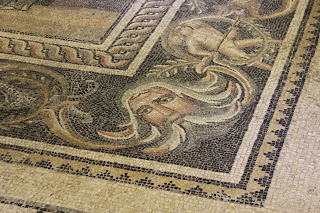The city of Zeugma was located on the banks of Euphrates, and is said to have been founded by Alexander the Great's generals back in 300 B.C. The Euphrates delta is historically known as the cradle of civilization with very fertile soil and rich culture. It is not surprising to find evidence of extraordinary culture in this area, and the city of Zeugma was such a find. Most of the city's treasures were discovered during digging and construction of a new dam on the Euphrates, and this dam would cause the ancient city of Zeugma to be permanently flooded. A hectic period of rescuing mosaics and artifacts started, and the pieces in this post became the Zeugma Mosaic Museum in Gazientep.
 |
| Not a painting |
 |
| Also - not a painting |
 |
| The details in these pieces were certainly worth contemplating. |
This is the most famous piece of mosaic in the museum, nick named The Gypsy Girl due to her unkempt hair and wild eyes. The rest of this mosaic is missing, so it is difficult to determine who this face is supposed to represent. Guesses are many, and usually the mosaics portray gods. One interesting hypothesis is that it could be a portrait of Alexander the great, wouldn't that be cool? Like the Mona Lisa, the eyes in this piece appear to follow you no matter where you are in the room. Only it's made of rocks. And nearly 2000 years older.














































